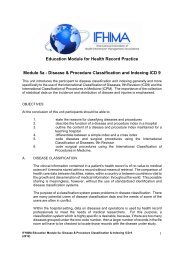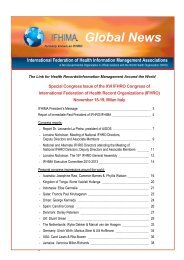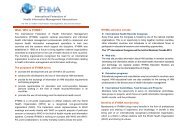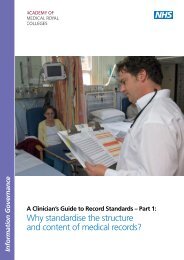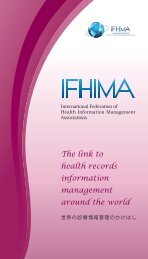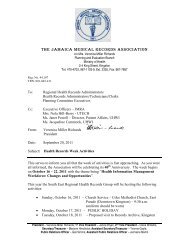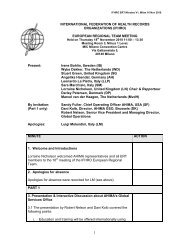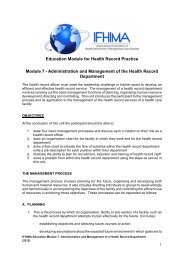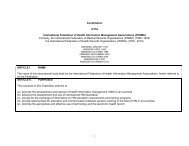Learning Packages for Medical Record Practice - ifhima
Learning Packages for Medical Record Practice - ifhima
Learning Packages for Medical Record Practice - ifhima
Create successful ePaper yourself
Turn your PDF publications into a flip-book with our unique Google optimized e-Paper software.
The way a number is presented also adds to the efficiency of the system. For<br />
example, an all-numeric number, presented in a fragmented <strong>for</strong>m (eg, 10 26<br />
42) or in boxes helps to reduce the misquotation rate.<br />
5. <strong>Record</strong> linkage or longitudinal records<br />
The main goal of record linkage is the centralization of all medical data about<br />
a particular patient to enable essential in<strong>for</strong>mation, about that patient, to be<br />
more readily accessible, and thereby creating a longitudinal record. This<br />
type of system requires the use of electronic health records in order to share<br />
patient in<strong>for</strong>mation.<br />
Hospitals and governments, concerned with an expanding volume of medical<br />
in<strong>for</strong>mation, are developing systems, designed to link all health records<br />
belonging to one patient that are physically located in different buildings or<br />
hospitals, within a city, state or province or across a country.<br />
In order to link records or data within or between hospitals, accurate and fast<br />
patient identification and number assignment are of prime importance. As<br />
mentioned previously, in many countries a unique number, often based on<br />
the birth date, is assigned at birth, and remains the standard identifier during<br />
the individual’s lifetime. This system readily enables record linkage.<br />
The perfect standard identifier, and thus the perfect record linkage number,<br />
should be:<br />
� unique (assigned to one person only)<br />
� universal (covering the population involved, eg. hospital or nation)<br />
� permanent<br />
� available (it must be present on each of any pair of records to be<br />
linked)<br />
� economical (it should consist of no more characters of in<strong>for</strong>mation<br />
than necessary, as each character creates additional computer<br />
storage space).<br />
It should also be noted that controversy exists surrounding the use of unique<br />
personal health identifiers because of the possible security issues, and many view<br />
it as a means of invasion of privacy<br />
B. FILING SYSTEMS<br />
<strong>Record</strong> identification systems and filing must go hand-in-hand, as the filing<br />
system depends on the identification system used. Filing is the systematic<br />
arrangement of records in a specific sequence so that reference and retrieval is<br />
fast and easy.<br />
Daily procedures in many areas of a clinic or hospital can be severely affected by<br />
poor management of health record services. It is there<strong>for</strong>e the responsibility of<br />
IFHIMA Education Module 3: <strong>Record</strong> Identification Systems, Filing and Retention of Health <strong>Record</strong>s<br />
(2012)<br />
10



